Core-XY based on Rat Rig V-Core and Duet 2 Ethernet
-
Just figured if Prusa can put the magnets under the bed so I can, or at least try it seeing as the pockets would have to be cut regardless; and leaving the top surface intact is just the icing on the cake for whatever the future brings that I haven't thought about yet. As of today I see no reason to glue anything to it, but that can change. I'm getting a 200x200mm knock off of the MK53 bed for my DIY I3 rework as well, so might be able to compare the two, if and when customs get a move on.
-
@snoozer said in Core-XY based on Rat Rig V-Core and Duet 2 Ethernet:
@deckingman
......................How did you mount your tooling plate to the printer ? how do you adjust it to be level in relation to your nozzle ?The tooling plate is fixed to a frame made from 2020 Vslot. The plate is 400mm x 400 mm and has a 240v silicone heater which is 360mm x 360 giving a 20mm border around the edges. I fitted 2 layers of semi rigid insulation under the aluminium to aid warm up time. I drilled 4 off 5mm clearance holes in the aluminium, about 70mm in from the font edge and 10mm in from the sides and counter sunk these holes. Then I used 5mm countersunk screws through these holes into Tee nuts in the aluminium extrusion. I just marked the holes and drilled them with a hand held power tool (but I'm well practised in that sort of thing). Here is a picture
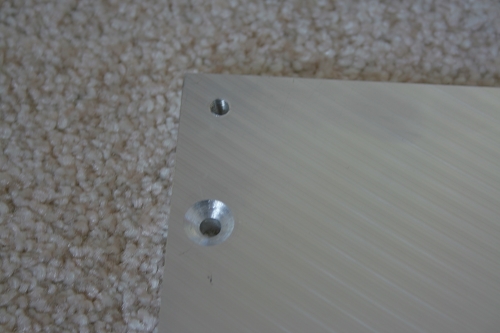
...and here is a picture showing the "sandwich".

I fixed some flat aluminium strip to the front and back to act as a trim and hide the edges. This is just screwed through into more tee nuts in the frame. Here is a view of the rear.
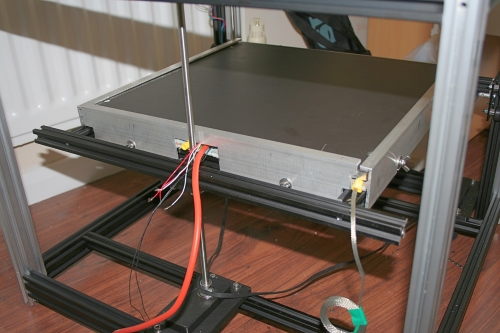
The bed is supported on 3 screws. I designed mounts that fix to the frame and take the lead screw nuts. There are O rings between the nut and mount.
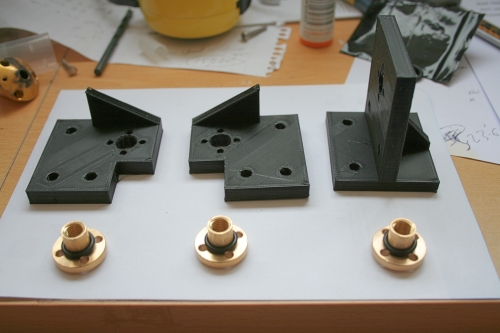
Here is on assembly seen from the side.
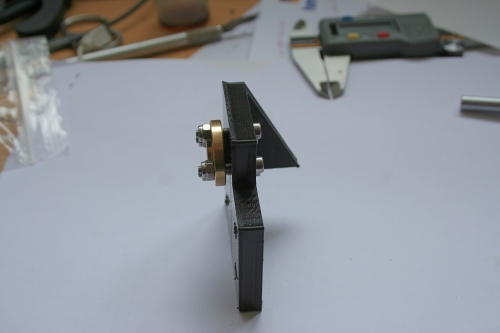
The nut is fixed to the mount using 4 bolts and "Nylok" nuts which are tensioned to just start compressing the O ring. This allows some flexibility in the joint to counter any effect of something not being completely square, as would be the case before the bed was levelled.
There are two vertical linear guides. These use OpenBuilds gantry plates, to the middle of which is fitted a ball joint type rod end fitting. A bolt fixes through the rod end ball into a Tee nut in the frame. Again, this constrains any X or Y movement but allows some flexibility for the bed to be levelled without imparting any twisting forces. Here is a picture of the lead screw nut and linear guide fixing in place.
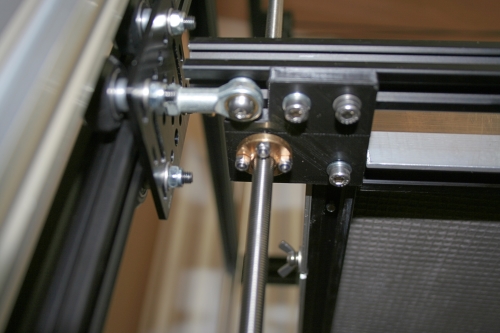
The bed is driven by a single Nema 17 and continuous belt. To level the bed, I simply slacken off two of the pulleys and rotate the screws. I position the nozzle close to each screw, then use a slip gauge of about 10mm thick and adjust the screws so that it juts touches the gauge. then tighten all the pulley and that's levelling done I dismantle or move the printer.
I use the nozzle as a probe. The nozzle mount has a precision positioning switch attached and can move a few mm in Z but not in X or Y due to a number of steel dowels running in oil filled bronze bushes. I doubt you'd be interested in how I do that but I can elaborate if you need me to (but I think you'll find all that information on my blog)..
Ref the spring steel - all those magnets seem a PITA and what is the benefit? AFAIK, it allows you to remove the plate and flex it to get the part off. But for the cost, you could likely buy a dozen sheets of glass that you can swap between - even more if you have to factor in the cost of getting magnets inserted into the build plate. 3D lac makes parts stick like the proverbial but when the glass cools, they just fall off. So I'm not sold on the idea personally.
-
@deckingman wow, that's well build and thanks for the detailed explanation. Having three lead screws is probably the 100% solution to have straight movement. I have as per the V-Core kit 2x 2020 v-slot extrusions where the bed in hooked in on the back. Two lead screws a bit off center towards the back. This WILL flex along the way on the 2020 v-slot from Z-min to Z-max. I am not sure how much ofc but its designed that way. I was always skeptical using belts to connect lead screws to transfer drive torque, I would have considered it to keep the drives in sync. Given your aim for perfection I assume possible flex in the belt drive with the load of the bed and print is not a real issue ? I particularly like the way you have the bed guide "rails" flexible connection to your bed, nothing can get bend or stuck that way. The play in those "ball joints" is small enough to not matter or did you put some pre-tension on ? Your concept with the three lead screws could be implemented on my V-Core as well. I think for this build I stay with the way the V-Core is designed and instead of leveling the entire bed frame structure to precision I maintain the precision adjustment between the aluminium bed and frame with three pre-tensioned springs, bolts and knurled nuts. In the process of the build and the ongoing addition of parts I have already settled for the fact this is only a start for me on the Core XY track. I will stick with the machined aluminium plate and glass surface idea and get that ready to rock. Its really the only thing left now, Piezo probe, aluminium bed and part cooling. Then tuning everything and setting up slicer profiles for different layers heights etc is the big job in my mind. The goal is obviously to make the Prusa as my go-to printer obsolete.
I almost forgot, do you have some aluminium spacers between your aluminium plate and the 2020 v-slot or is the insulation as such the spacer ? Re drilling, I have the use of the bench drill in a friends workshop, Simply drilling holes in the right place and proper angle wont be a problem. Making slots and precise holes for magnets would have been but I am not taking that route, Glass it is.....
Thanks !!!
Jan -
@bearer the bed of the Prusa mk3 is a PCB heater, no solid aluminium. The magnets are embedded in that, It feels like a pretty strong pull from the magnets, I doubt you get the same result easy through an aluminium plate unless you leave a very thin thickness of material where the magnets are. But I guess testing would not be that hard if you had a piece of aluminium cut off or so.
Jan
-
@deckingman and WOW again re the "floating" hotend. Just looked through the blog. Have you chosen the mechanical precision approach over lets say a piezo cause that's what you can do best or is there other considerations that stopped you from using a piezo probe ?
Jan
-
@snoozer I don't have spacers between the aluminium plate and the 2020 extrusion but if I was doing it again, I would use them. In fact, it's on my list of things to do. The reason is that the semi rigid insulation is slightly compressible, which means that if I don't tighten the fixing screws by the same amount, it is possible to distort the plate.
I have no problems with belt stretch and that is with using standard 6mm GT2 timing belt. But I do use 1mm single start Lead screws so the torque requirement to drive them is low. Of course, you don't have to use 6mm wide belts, nor indeed do you need to use 2mm pitch belts. The steps per mm are determined by the lead of the screws and the step angle of the motor. So the interconnecting belt can be any size and pitch.
Ref machining slots in aluminium - I have done this in the past using a wood working router and HSS (high speed steel) cutter. Paraffin is the best lubricant to use when machining aluminium IMO but if you take small cuts, you can do it without any coolant or lubricant.
-
@snoozer said in Core-XY based on Rat Rig V-Core and Duet 2 Ethernet:
@deckingman and WOW again re the "floating" hotend. Just looked through the blog. Have you chosen the mechanical precision approach over lets say a piezo cause that's what you can do best or is there other considerations that stopped you from using a piezo probe ?
Jan
Several reason really. Firstly, fitting a Piezo to a Diamond hot end is difficult to do. Secondly, a Peizo needs some sort of interface board whereas a simple switch does not. Lastly, the "mechanical approach" isn't a problem for me but I can see how it might be for a "non-mechanical engineer". Having said that, it's not hugely difficult - the mounts that take the bushes and dowels are both printed parts so it's not the ultimate in precision engineering.
-
@snoozer One other thing before I forget. When using a thick aluminium plate, mounting of the temperature sensor requires some thought. The "normal" method is to have the sensor built into the heater or sandwiched between the heater and the aluminium plate. This is problematic because when the heater comes on, the interface between the heater and the plate heats up quickly and so the heater turns off again (or the PWM value reduces). But it takes time for the heat to penetrate the plate and reach the upper surface. So if the heater is cycling on and off (or high and low) quite quickly due to the position of the temperature sensor, then it takes an inordinately long time for the top surface of the plate to reach print temperature. My solution was to drill a 3mm diameter hole in the edge of the plate, as deep as possible and as close to the top surface as possible without breaking through, and fit the temperature sensor in there. So the sensor "sees" the temperature close to the upper surface, rather than the temperature of the bottom surface. Of course, after a period of time, thermal conduction means that both surfaces will be more or less at the same temperature but during the warm up period, this is not the case.
-
@deckingman I know what you mean, in my original design I had a small slot and hole designed in my CAD model for the thermistor. So for my current plan I thought of either having a hole in the center from below or as you do from the side.
Jan
-
I have thought of redesigning my hotend/extruder mount to use less space and also to include a piezo probe. Someone else has done a pretty good looking design already.
https://www.thingiverse.com/thing:3600079
I have exported the design from OnShape to be able to work on it in Fusion 360. This should resolve my desire for a more compact mount including piezo probe. I share it once I am done.
Jan
PS: I have abandoned the idea of a quick release tool holder for this printer. Maybe I look into that idea again on my next build.
-
Very frustrating day today...... the design above was evidently made around a clone Titan Aero, the original has issues fitting on the mount. I needed longer bolts for the stepper mount and the hotend is shorter apparently, I had to trim some of the part cooling duct off. The belt attachment is for ppl with a LOT of patience but I did get it done in the end. A nice baseline design but I will do that again from scratch and fix the issues I found. So far I can not recommend it for an original E3D Titan Aero. On the positive side, its very compact and gives a few mm more print area.
Jan
-
Hello,
I am finally getting somewhere. After resolving some of the issues with the Titan Clone Mount I spend some time getting Slic3rPE set-up. My approach to that was basically a mix of the Prusa settings and some input from the a Railcore II300 profile I found online. I can not claim that I would know all the details what each parameter actually does but so far I have a working printer setup and print setup for 0.2mm and 0.1mm layer height. One of the things I struggled with most was priming of the nozzle prior to the actual print. The way Prusa does it did not really work so I have taken that from a Railcore profile. I can run both print profiles at 100% with very nice looks and at 200% for a very fast print. I have speeds set to 60mm/s for perimeters 30mm/s for external perimeters and 80mm/s for infill and support, 20mm/s for the 1st layer. Some distortions are noticeable after sharp corners for example printing a cube. Printing it at 200% speed that obviously gets worse. It is in no way so bad that it would worry me for now but something that shows there is some unwanted vibration. I will look into that once I have my final bed finally on the printer.
Another issue I ran into was heat in the wrong place of the hotend. I had the Titan Aero fan set to 70% to reduce noise. That was not a good idea, on an longer print I started missing steps on the extruder and it finally ground through the filament. The problem was the fan was to slow to provide enough cooling. So my heatbreak was clogged and I had to disassemble the Titan Aero to remove the blockage. This has not happen since I run at 100% fan speed.
I have no good light here to take pictures of prints, I take them with me to the office and post pictures later today or tomorrow.
Have FuN!
Jan -
@deckingman, You mentioned 3DLAC as printing aid you use on your glass surface, I have been looking at it seems there are 2 versions, an aerosol can called 3DLAC and a pump spray called 3DLAC Plus. Which is the one you use successful ? I have ordered 4 float glass surfaces now 320x320x6mm at 27 Euro. I find that is dead cheap, really no point if wrecking my head over flex plates. With the machined aluminium its the first time I try my virtual UK shipping address provided by DPD. I hope that works out.
Have FuN!
JanPS: The glass comes from a local supplier, If I get a ride tomorrow I can pick it up. At that price I assume its measured with a measuring tape and hand cut. Probably have to find a way to make the edges less dangerous

-
@snoozer 3DLac in an aerosol is the original. The pump action is a later addition to the range. I have used both with equal success. I suspect there isn't much difference in the actual product so go with whichever is most readily available or cheaper.
On the subject of glass, I bought mine from a local supplier but asked them to polish the edges. It might be worth asking your supplier if they offer the same service.
-
I have to take a step back for a few days. I was spending way to many hours getting nowhere on Fusion 360 for my Titan Aero mount with piezo. Turns out to difficult to print or to bulky. Having the flue as well in the moment. I leave it rest for a few days. Still waiting for final deliveries for optical endstops, tooling plate, 230V AC heater etc......
Be back soon
Jan -
Hi,
I really took some time off the printer and started from scratch with the Titan Aero mount including the piezo and having a detachable extruder from the base plate. Some preliminary work is shown below. Base plate and bolted on extruder mount with a flat part for the piezo, it can be seen slightly visible. A couple of guides for the PTFE tube and wiring. A bit of a support for a wire guide will bolt on to the back that's what the M3 nuts are for. On the side is also the mount for my (still) mechanical end stop. Playing with it in hand pushing down on a surface it is VERY sensitive but wont know for sure until its mounted.
After all that I have to say I am not sure I would use a Titan Aero next time. I find the mount requires just to much asymmetric shapes and it is not easy to get the nozzle centered. Also what I have notices is yes, it is very compact vertically but its not ideal horizontally. Have been looking at the BMG M extruder now with Mosquito hotend, that looks way easier due to the symmetry of everything and yes its way more expensive...... next printer



-
Have you considered using an underslung mount for the Aero? Like this? https://www.thingiverse.com/thing:2849355
It rotates the Aero 90 degrees and has the motor riding under the rail.
-
I would find that a waste of build height to be honest, That vertical compactness of the Titan Aero was THE main reason why I got it. The BMG./Mosquito design could be placed mostly above the gantry to maintain build height. I think that I have to accept the limitations at this point. What annoys me the most is that the belt fastening/tensioning is part of the hotend/extruder mount. In any future design I would make sure mechanics are independent of hotend and other components.
Have FuN!
Jan -
Right, I am back to my 1st design (Orange PLA further up in a pic), all I am gaining on the Y axis would be 7mm with the new design or so, cant be bothered. The underslung mount and some others similar lose significant Z height, I prefer not to follow down that road. On top of those issues I have not yet received my machined cast Aluminium plate. The supplier in the UK did not want to send to IRL so I used Parcel Wizard in NI with a UK Address. The supplier had all the details correct as confirmed by mail BUT left some details out on the shipment so now DPD can not associate the delivery to my Parcel Wizard Account....... emails back and forth now for a week...... I nothing happens I order a new plate from IRL this time.
I have been looking a lot more into the Mosquito Magnum and the BMG M, I see a lot of advantages mechanically with that entire idea, The heat-break no longer has to deal with any mechanical load and no more frustration on nozzle changes with spinning heatblock. The nozzle change drama is what stops me from using bigger nozzles on big prints, I hardly ever need fine detail, just strong and fast is what I need most times. The downside is the price, the lot with extruder, hotend, heater etc comes to approx 380 Euro. Have to sleep a few nights over that.
So all in all a bunch of delays by choice and inflicted from outside.
Jan -
I hope snoozer and mods don't mind, RatRig has a sale for this kit ATM